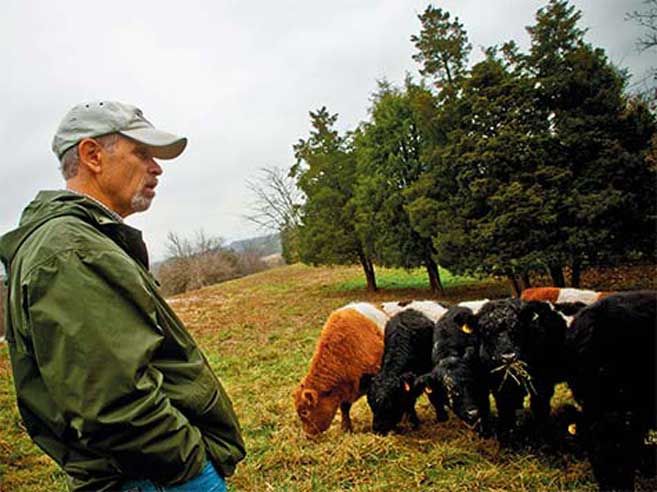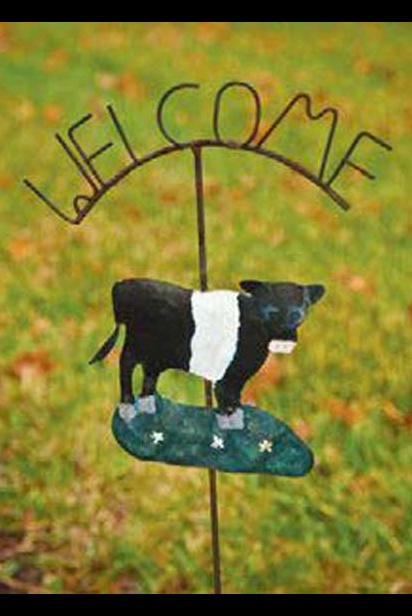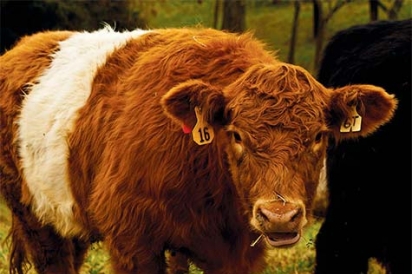Saddle to Cattle
Jon Bednarski became a farmer when he won a saddle through a raffle.
A Vermont transplant who sold log homes for a living, he was shopping with his daughter at a horse supply store when he bought raffle tickets for the saddle, and won.
Owning a saddle led to buying a horse for his daughter, Kristin, who was taking riding lessons. Needing space for a horse led to buying 35 hardscrabble acres in eastern Oldham County in 2000. The farm included 15 acres of woodland and had many of the same issues that other central Kentucky farms have: poor topsoil from generations of conventional farming, erosion from careless farming habits, and lots of invasive and undesirable species, like multiflora rose, hedgeapple and black locust trees.
Bednarski had worked summers on his grandfather’s Vermont dairy farm, but had no other experience in farming. Still, in 2003, his wife, Sylvia, and his children, surprised him on Father’s Day with a gift of three Belted Galloway heifers. “We’ve always liked the heritage breeds,” says Sylvia.
“It’s a medium-frame, efficient animal,” says Bednarski. The breed originated in Scotland, so cold and wind suit them. While the animals take longer to grow than, say, Angus, they efficiently convert grass and hay to meat. That is, they are efficient at converting the “solar power” of sunlight on pasture, rather than relying on corn, which can be expensive to buy and requires intensive fossil-fuel inputs to produce. “They eat a fraction of the feed,” that other meat cattle eat, says Bednarski.
If most beef cattle reach preferred weight in 14 to 16 months, his cattle might require 21 to 24 months. But Bednarski doesn’t spend much money on grain, he gets more meat off a carcass and some consumers think the meat tastes “beefier.”
For him, the tradeoff made business sense. However steep the farming learning curve might have been, Bednarski set out to scale it, and then some. He and Sylvia, an avid outdoorswoman, knew immediately on buying the farm that they wanted to not only restore the land but farm it responsibly. “We are at the headwaters of Harrods Creek,” he says. Whatever happens there flows through Oldham County to Louisville.
To learn how to take care of his land, he consulted folks at the US Department of Agriculture’s Natural Resource Conservation Service, who advised him to fence off woodlands and to build a pond the animals can’t reach. Otherwise, says Bednarski, the cows head for a pond on the first hot day and “stand in the water and pee and poop.” In addition, they degrade the land around the pond, causing erosion.
As a result of his efforts, in October, Bednarski became the first Kentucky recipient of the Leopold Conservation Award, named after conservationist Aldo Leopold, which came with a $10,000 prize.
As he worked with conservation specialists to identify invasive species, improve creek beds, plant trees and improve feeding areas, Bednarski was also learning how to raise cattle, first through the University of Kentucky’s Master Cattlemen programs, then through Master Grazer programs.
Learning how to grow good pasture and how to move animals is critical to growing animals on grass.
“You’re a forage farmer first,” he says. “We learned that the hard way.”
But the learning curve didn’t stop with raising healthy, efficient animals on well-maintained farmland. To make money from his cattle, Bednarski had to learn to sell a beef product that had been marginalized by the wildly successful Certified Angus Beef marketing program, but still sold at a premium. Farmers’ markets were his obvious choice, but when he started, meat was uncommon at many Louisville markets. “Taking meat to a farmers’ market (then) was just crazy,” says Bednarski.
However, the strategy worked, and since then his beef has begun selling at Paul’s Fruit Markets in Louisville and is used at the Mussel and Burger Bar in Jeffersontown.
But there is more to be done. In the years since he began selling beef at farmers’ markets, consumers have only become more interested in local food. Kentucky has more beef cattle than any other state east of the Mississippi River. It makes sense to many beef farmers to hold their cattle until they mature, instead of shipping them out west for finishing. Not long ago, Bednarski and Henry County farmer Chris McBurney began discussing how area farmers might participate in this growing interest in locally grown meat.
The two men contacted other livestock farmers in surrounding counties, extension agents and interested parties to discuss the idea of building a processing plant, perhaps in Henry County, perhaps to process several species — including beef and pork — to help local farmers access the greater Metro Louisville and Cincinnati marketplaces. Those plans are going forward. A feasibility study has been completed, and the group is now meeting with potential managing partners.
Despite coming to farming in midlife, Bednarski is not slowing down. He’s purchased 100 acres in Henry County where conservation and forage upgrades continue. “I have endless energy to farm all day long,” he says.
RECIPES
Slow-Cooker Brisket (or Chuck)
Kentucky Meat Loaf
Ingredients
- 2 slices sandwich bread, or
- 1 cup cracker crumbs or unseasoned breadcrumbs
- 1/8 cup milk or beef broth
- 1 egg
- ½ cup fresh minced parsley (more or less)
- 1 teaspoon salt
- ½ to 1 teaspoon freshly ground pepper
- 1 or 2 minced garlic cloves
- 1 tablespoon Worcestershire sauce
- 1½ pounds ground beef
Instructions
- Heat oven to 375°.
- Combine bread (or crumbs) in a large bowl with milk (if using dry crumbs, increase liquid to ½ cup). Set aside for 5 minutes, then use a fork to break bread into small pieces. Add egg and beat. Add parsley, salt, pepper, garlic and Worcestershire and stir well to combine. Add beef and use a fork to break it up and blend it with the other ingredients. Form into a long loaf, 3 inches wide (or so) on a lightly oiled cookie sheet with shallow sides. Bake 40 to 50 minutes, or until the loaf is cooked through. Serve with home fries or baked potatoes. Serves 6 to 8. Makes great sandwiches.






